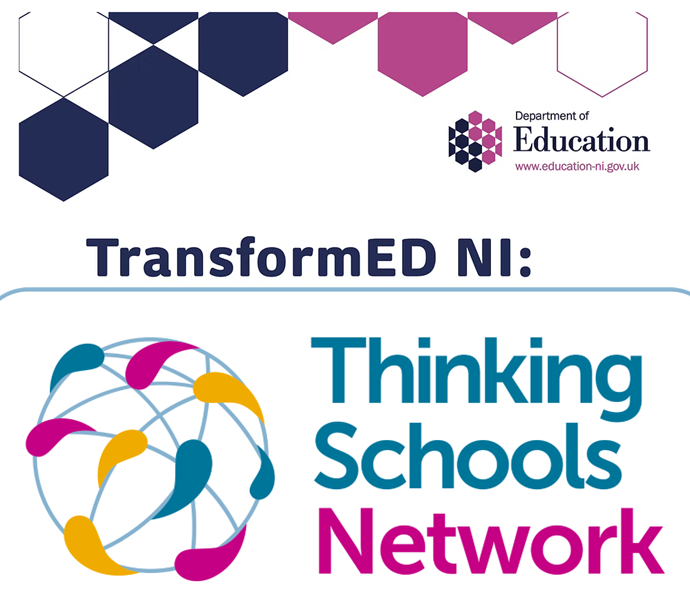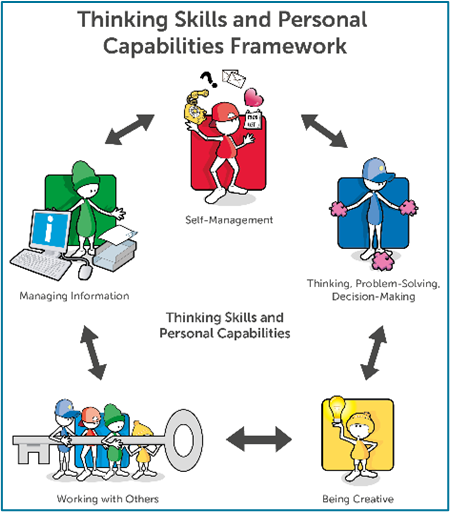Empowering Independent Thinking: A Reflection on Teaching Practices at Westbrook Primary School
Promoting metacognitive and independent thinking
By Amarin Hans
By promoting reflection and independent thinking, we are equipping our students with the skills they need to become thoughtful, engaged learners.

Amarin Hans
As a former educator at Westbrook Primary School, I have seen first-hand the impact of innovative teaching methods on student engagement and learning.
Westbrook school is a larger-than-average multi-faith academy located in Heston, known for its commitment to inclusivity, including a dedicated center for children with visual impairments. The student body includes a high percentage of pupils from ethnic minorities, those with English as an Additional Language (EAL), and those eligible for Free School Meals/Pupil Premium (FSM/PP), alongside many children with Special Educational Needs and Disabilities (SEND).
With these unique demographics, the school has always explored ways to enhance our teaching practices to meet the needs of our diverse learners. The 2023 academic year brought an increase in Early Career Teachers (ECTs), with six joining in September, which prompted us to revisit our approaches to teaching and learning.
The Power of Retrieval Practice and Elaboration in Learning
In line with Ofsted’s research on memory and learning, our focus has been on implementing strategies that effectively help students integrate new knowledge into their long-term memory. A key method we use is retrieval practice, which involves recalling previously learned information to reinforce memory. Research has shown that this approach is more effective for knowledge retention than simply re-reading material.
"This approach enabled students to express their understanding using both writing and drawing, making it accessible to all learners, including those with SEND and EAL needs".
Another strategy we value is elaboration—encouraging students to describe or explain what they have learned in detail. This not only helps them make connections among ideas but also links new information to their personal experiences and existing knowledge.
"Elaboration is defined as describing and explaining something learned to others in some detail. Ideally, this involves making connections among ideas and connecting the material to one’s memory and experiences. It can also be useful for learners to ask themselves or each other questions that require making connections between ideas or explaining them. This can clearly be built into classroom activities".
To facilitate these practices, we introduced end-of-unit reflections, allowing students to revisit, consolidate, and reflect upon their learning. Using Edward de Bono’s Thinking Hats, students could explore different aspects of their learning experiences: their feelings about the topic, challenges faced, enjoyable parts, new processes learned, and opportunities for creativity. This approach enabled students to express their understanding using both writing and drawing, making it accessible to all learners, including those with SEND and EAL needs.

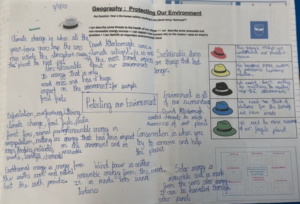
From Thinking School to Independent Thinkers
Westbrook Primary School has long embraced the ethos of a Thinking School, a philosophy that became official in July 2023. Our commitment to Thinking Maps and Thinking Hats has been integral to our curriculum for many years. However, during a 2022 training session with Thinking Matters Consultant, Peter Short, it became evident that promoting independent thinking among our students was crucial. We realised the importance of giving children the freedom to choose how they organise and categorise information, thus fostering their ability to think independently.
This realisation led to the development of Thinking Booklets—unstructured spaces where students could freely record their thoughts and create their own maps across all subjects. These booklets aimed to reduce teacher workload related to sticking maps into books and to alleviate concerns about presentation standards. Importantly, these thinking booklets were not to be marked but used as a tool for self-reflection and independent learning.
Challenges and Adaptations
Despite the introduction of thinking booklets, some teachers felt that the process led to duplication of work, as they had to ask students to reproduce their thinking maps in exercise books for easier access during subject-specific evaluations. This feedback prompted a shift towards using Thinking Frames (an evolution from Hyerle’s Thinking Maps), which students could independently draw directly into their exercise books.
From this adaptation, the concept of end-of-unit reflections emerged. These reflections would be directly incorporated into exercise books after a unit’s completion, allowing students to engage with their knowledge organisers while reviewing their prior learning. This approach provided a more streamlined way for students to consolidate their learning and for teachers to assess understanding.
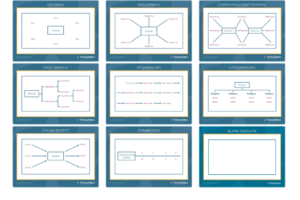
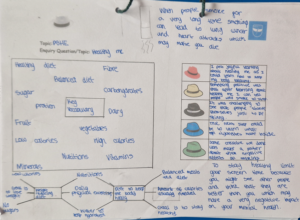
Implementing End-of-Unit Reflections
To successfully introduce end-of-unit reflections, I initiated a trial with Years 2, 5, and 6, gathering feedback from teachers on the practicality and benefits of this approach. The positive response led to a broader implementation, supported by training sessions and step-by-step guides during staff INSETs. Engaging teachers in the trial phase and emphasizing the reflections’ importance helped gain their buy-in. The end-of-unit reflections were subsequently made a performance management target to ensure consistent use across the school.
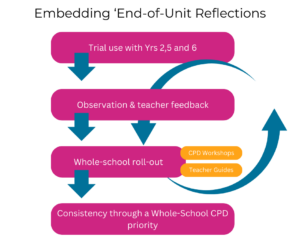
Benefits of End-of-Unit Reflections
Our experience has shown that end-of-unit reflections offer several advantages:
- Enhanced Assessment: These reflections provide a valuable comparison with initial knowledge checks, offering insights into student progress.
- Reduced Teacher Workload: The reflections are child-led, allowing students to take ownership of their learning.
- Consistency Across Subjects: A common metacognitive language is developed, enhancing coherence in teaching and learning practices.
- Opportunity for Reflection and Consolidation: Students have a structured opportunity to think about what they’ve learned and how they’ve learned it.
- Increased Classroom Oracy: Sharing reflections encourages students to articulate their thoughts, enhancing verbal communication skills.
- Accessibility for All Learners: Visual representations and flexible thinking frames make the reflections accessible to all students, including those with SEND and EAL needs.
- In-Depth Insights: Although informal, these reflections provide valuable qualitative data about students’ understanding and experiences, allowing teachers to tailor their instruction.
- Preparation for Formal Assessments: Reflections can serve as a prelude to formative assessments, such as quizzes, by reinforcing knowledge in a low-pressure environment.
Challenges and Reflections on the Journey
While the introduction of end-of-unit reflections has been largely positive, we faced several challenges along the way:
- Time Constraints: Finding the time to integrate new practices into an already packed curriculum was challenging.
- Teacher Reluctance: There was initial hesitation from teachers to adopt a new method, especially concerning how to maintain presentation standards.
- Subject-Specific Application: Deciding which subjects should consistently use reflections required careful consideration.
Despite these challenges, the journey has been rewarding. By promoting reflection and independent thinking, we are equipping our students with the skills they need to become thoughtful, engaged learners. As a Thinking School, our commitment remains to continuously evolve and adapt our practices to best support our students’ learning and development.
